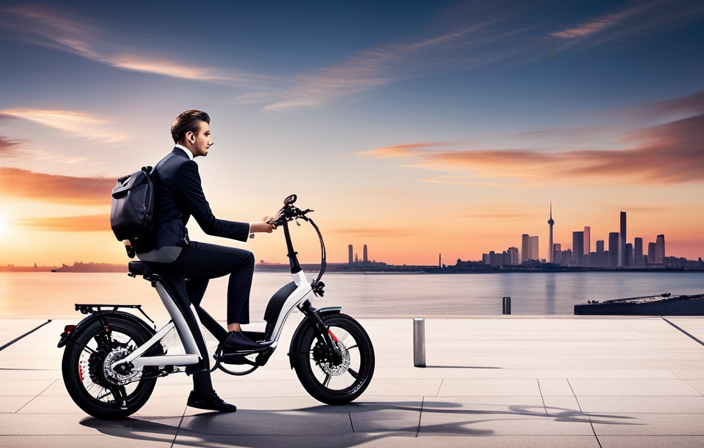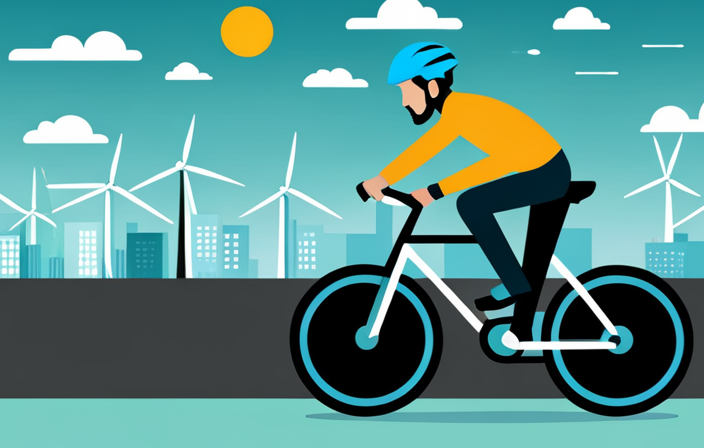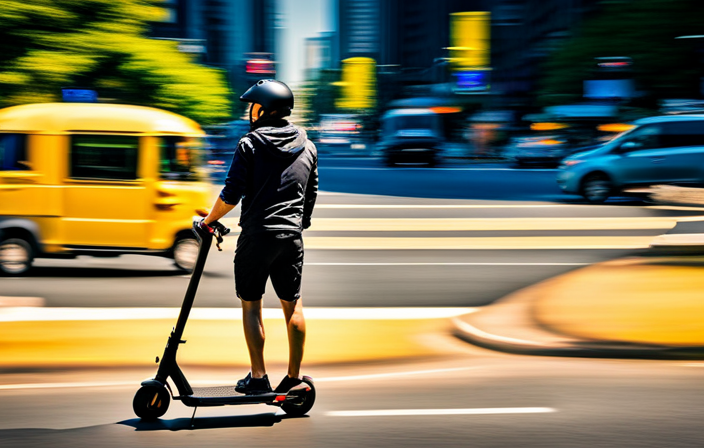Imagine this scenario: you’re riding your electric bike down the road, enjoying the breeze in your hair and the excitement of the journey. However, you quickly notice that your brakes are not working properly. A sense of panic washes over you as you attempt to troubleshoot the issue.
Fear not, for in this article, we will guide you through the step-by-step process of fixing the brakes on your electric bike. With a little know-how and the right tools, you’ll be back on the road with confidence and peace of mind.
Key Takeaways
- Regularly inspect and adjust brake cable tension for optimal performance
- Bleed the brakes (if hydraulic) to replace old fluid with fresh fluid
- Reinstall brake pads by removing the old ones, cleaning the caliper and rotor, and inserting new pads
- Regularly test brake functionality and troubleshoot issues such as squeaking or sticking brakes
Assessing Brake Performance
You should start by testing the brake performance of your electric bike. Evaluating the brake effectiveness is crucial for troubleshooting brake issues.
Here’s a step-by-step guide to help you assess your brakes. Begin by finding a safe and open area to ride your bike. Start pedaling and gradually increase your speed. Apply the brakes gently and observe how quickly your bike comes to a stop. If the stopping distance is longer than usual or if you notice any squeaking or grinding noises, it indicates a problem with your brakes.
Additionally, pay attention to the brake lever’s responsiveness and the overall feel of the braking system. Once you have evaluated your brake performance, you can move on to the next step of gathering the necessary tools to fix any issues found.
Gathering the Necessary Tools
First, make sure you have all the tools required to complete the task. Here are some tool recommendations for fixing the brakes on your electric bike:
| Tool | Purpose |
|---|---|
| Allen wrench set | Used to loosen and tighten brake components |
| Adjustable wrench | Helps with adjusting brake cables |
| Screwdriver | Used to remove screws and bolts |
| Brake cleaner | Cleans and degreases brake components |
| Rag | Used for cleaning and wiping off excess dirt and grease |
Before starting, remember to take some safety precautions. Wear protective gloves and goggles to avoid any injuries. Ensure that your bike is on a stable surface and the brakes are fully disengaged. Now that you have gathered the necessary tools, you can proceed to the next step of removing the brake pads.
Removing the Brake Pads
To remove the brake pads, begin by loosening the screws that hold them in place. Use a screwdriver to turn the screws counterclockwise until they are loose enough to be removed. Once the screws are loosened, carefully pull the brake pads away from the caliper. Be cautious not to damage the brake rotor while doing this.
Installing new brake pads:
- Position the new brake pads into the caliper, making sure they are aligned correctly.
- Tighten the screws to secure the brake pads in place.
- Test the brakes by squeezing the brake lever to ensure proper installation.
Troubleshooting brake pad noise:
- Inspect the brake pads for any signs of wear or damage.
- Clean the brake pads and caliper if necessary.
Inspecting and cleaning the brake calipers will ensure optimal brake performance and prevent any issues from arising in the future.
Inspecting and Cleaning the Brake Calipers
Inspect and clean the brake calipers regularly to ensure optimal performance and prevent potential issues.
Start by removing the wheel from the bike frame to gain access to the brake caliper.
Using a clean cloth, wipe away any dirt or debris from the caliper surface.
Next, inspect the caliper for any signs of damage or wear, such as bent or broken parts. If any issues are found, it may be necessary to replace the caliper.
To clean the caliper, use a brake cleaner spray to remove any built-up grime or brake dust. Be sure to follow the manufacturer’s instructions for proper use.
Additionally, check the brake pads for wear and replace them if necessary.
By regularly inspecting and cleaning the brake calipers, you can prevent common brake issues and ensure your electric bike’s brakes are in top-notch condition.
Transitioning into the next section, let’s now discuss replacing worn brake pads.
Replacing Worn Brake Pads
When brake pads become worn, they should be replaced to maintain optimal braking performance. Choosing the right brake pads is crucial for ensuring safety and efficiency. Look for brake pads specifically designed for electric bikes, as they are formulated to handle the unique demands of electric braking systems.
Common signs of worn brake pads include a squealing or grinding noise when braking, reduced braking power, and a longer stopping distance. To replace the worn brake pads, start by removing the retaining pin or bolt that holds the old pads in place. Slide out the old pads and insert the new ones, making sure they are properly aligned with the brake caliper. Once the new pads are in place, reattach the retaining pin or bolt.
This will ensure a smooth transition into the subsequent section about adjusting brake pad alignment.
Adjusting Brake Pad Alignment
To ensure optimal braking performance, it is crucial to have proper brake pad alignment on your electric bike. Proper alignment ensures that the brake pads make full contact with the braking surface, allowing for efficient stopping power.
To adjust the brake pad alignment, follow these steps:
- Loosen the brake pad mounting bolts using a 5mm Allen wrench.
- Align the brake pads parallel to the rim or rotor surface, ensuring equal distance on both sides.
- Tighten the mounting bolts while holding the brake pads in place.
- Check the alignment by squeezing the brake lever and observing if the pads make even contact with the rim or rotor.
Importance of proper brake pad alignment:
- Ensures optimal braking efficiency.
- Prevents premature wear and tear of the brake pads.
- Enhances overall safety while riding.
- Improves the lifespan of other brake components.
Avoid the following common mistakes when adjusting brake pad alignment:
- Unequal pad alignment.
- Loose mounting bolts.
- Misaligned calipers.
- Incorrect pad-to-rotor or pad-to-rim spacing.
Next, we will discuss the importance of lubricating brake components.
Lubricating Brake Components
Lubricating the components of your braking system is essential for maintaining smooth and efficient operation. When it comes to lubricating your electric bike’s brake components, there are a few different lubricant options to consider.
One popular choice is a silicone-based lubricant, as it is compatible with most brake systems and provides long-lasting lubrication. Another option is a graphite-based lubricant, which can help reduce friction and wear on the brake components.
Whichever lubricant you choose, it’s important to apply it properly. Start by cleaning the brake components with a mild detergent and water, then dry them thoroughly. Apply a small amount of lubricant to the pivot points and moving parts of the brake calipers and levers. Be careful not to over-lubricate, as this can lead to a decrease in braking performance.
Once you have lubricated the brake components, you can move on to the next step of checking the brake cables and housings for any signs of wear or damage.
Checking Brake Cables and Housings
Now that you have lubricated the brake components of your electric bike, it is important to also check the brake cables and housings for any potential issues.
Common brake cable issues include fraying, kinking, or rusting. Begin by visually inspecting the cables and housings for any signs of damage. If you notice any issues, it is crucial to replace the affected parts immediately to ensure safe and effective braking.
Additionally, troubleshooting tips include checking for proper cable tension and ensuring that the cables are properly aligned with the brake levers and calipers. To prevent brake cable damage, regularly clean and lubricate the cables, and avoid excessive bending or twisting. Proper maintenance techniques also include periodically adjusting the brake cable tension to ensure optimal performance.
Transitioning into the subsequent section, we will now discuss how to adjust brake cable tension for your electric bike.
Adjusting Brake Cable Tension
Inspect the brake cable tension and make necessary adjustments to ensure optimal performance. To properly adjust the brake cable tension on your electric bike, follow these steps:
-
Start by locating the barrel adjuster on the brake lever. This is usually a small cylindrical component that can be turned by hand.
-
Turn the barrel adjuster clockwise to increase the cable tension or counterclockwise to decrease it. Make small adjustments and test the brakes after each turn.
-
If the brakes still feel loose or unresponsive, you may need to tighten the brake cable itself. Locate the brake cable anchor bolt near the brake caliper and use a wrench to tighten it.
By regularly inspecting and adjusting the brake cable tension, you can ensure that your electric bike’s brakes perform optimally and minimize the risk of any potential braking issues.
Moving on to bleeding the brakes (if hydraulic), it is essential to…
Bleeding the Brakes (if hydraulic)
To ensure optimal performance, it’s important to bleed the hydraulic brakes on your electric bike. Bleeding the brakes involves removing any air bubbles that may have entered the system, ensuring that the brakes function properly. Here are the steps to bleed the brakes on your electric bike:
-
Start by locating the bleed port on the brake lever. This is where you will attach the bleed kit.
-
Attach the bleed kit to the bleed port and open the valve on the kit. This will allow the brake fluid to flow through the system.
-
Slowly squeeze the brake lever to force the old brake fluid out of the system. Keep an eye on the fluid level in the bleed kit and refill it as necessary.
-
Repeat this process until all the old fluid has been replaced with fresh fluid.
-
Once the bleeding process is complete, close the valve on the bleed kit and remove it from the bleed port.
Incorporate these bleeding techniques to avoid common mistakes and ensure a smooth, efficient brake system.
Now, let’s move on to reinstalling the brake pads.
Reinstalling the Brake Pads
Once you have completed bleeding the hydraulic brakes on your e-bike, it’s time to reinstall the brake pads. Properly aligning the brake pads is crucial for optimal brake performance. Follow these step-by-step instructions to ensure a successful installation.
First, remove the retaining pin or bolt that holds the brake pads in place. Carefully slide out the old brake pads from the caliper. Inspect them for wear and replace if necessary.
Next, clean the caliper and rotor with isopropyl alcohol to remove any dirt or debris. This will ensure a smooth contact surface for the new brake pads.
Now, insert the new brake pads into the caliper, making sure they are positioned correctly. Refer to the manufacturer’s instructions for proper alignment.
Reinstall the retaining pin or bolt to secure the brake pads in place. Ensure they are tightly fastened.
To troubleshoot brake squeal, try applying a small amount of brake lubricant to the back of the brake pads. This can help reduce friction and noise.
With the brake pads successfully reinstalled, you can now move on to testing the brake functionality.
Transitioning into the subsequent section: Now that the brake pads are properly aligned, it’s time to test the functionality of your brakes.
Testing Brake Functionality
To ensure the optimal performance of your electric bike’s brakes, it is crucial to regularly test their functionality. By doing so, you can identify any potential issues and take the necessary steps to rectify them. Regular brake testing not only ensures your safety but also extends the lifespan of your brake system.
Here are some common brake issues you may encounter and troubleshooting tips to address them:
-
Squeaking or squealing brakes: This can often be caused by contaminated brake pads. To fix this, remove the pads and clean them thoroughly with rubbing alcohol.
-
Weak braking power: If your brakes feel weak or do not engage properly, it may be due to worn brake pads. Replace them with new ones to restore optimal braking performance.
-
Brake lever sticking: A sticky brake lever can be caused by dirt or debris in the lever mechanism. Clean the lever thoroughly and lubricate it with a silicone-based lubricant.
Regular brake testing is vital for maintaining your electric bike’s safety and performance. Now, let’s move on to the next section and learn how to adjust the brake lever reach.
Adjusting Brake Lever Reach
Adjusting the brake lever reach allows you to customize the position of the lever for a more comfortable and efficient braking experience.
To begin, locate the reach adjustment screw on the brake lever. It is typically located near the pivot point of the lever. Use a screwdriver to loosen the screw, allowing the lever to move closer or farther from the handlebar.
Find the optimal position that feels comfortable for your hand size and riding style. Once you have adjusted the lever, tighten the reach adjustment screw to secure it in place.
This adjustment can also help troubleshoot brake noise. If you hear any squeaking or grinding sounds when braking, try adjusting the lever position to ensure proper engagement with the brake pads.
Now that the brake lever reach is adjusted, let’s move on to fine-tuning the brake performance.
Fine-tuning Brake Performance
Now that you’ve adjusted the brake lever reach, you can fine-tune the performance for a smoother and more responsive braking experience.
To improve brake modulation, follow these steps:
-
Adjust brake pad alignment: Ensure the brake pads are properly aligned with the rim or rotor surface. Misaligned pads can cause poor braking performance and noise.
-
Check pad wear: Inspect the brake pads for excessive wear. If they are worn down, replace them promptly to maintain optimal braking power.
-
Clean the braking surface: Use a clean cloth and rubbing alcohol to remove any dirt or debris from the rim or rotor surface. This will ensure maximum contact between the pads and the braking surface.
-
Lubricate moving parts: Apply a small amount of lubricant to the pivot points and moving parts of the brake system. This will reduce friction and promote smooth operation.
By following these steps, you can improve brake modulation and troubleshoot any brake noise issues.
Now, let’s move on to regular maintenance tips for long-lasting brakes.
Regular Maintenance Tips for Long-lasting Brakes
For optimal brake performance and longevity, it’s important to regularly maintain your braking system. This includes routine inspections, cleaning, and adjustments. One crucial aspect of maintenance is brake pad replacement. Over time, brake pads wear down and lose their effectiveness. To replace them, follow these steps:
- Start by removing the wheel from the electric bike.
- Locate the brake caliper and remove the retaining clip or pin.
- Take out the old brake pads and insert the new ones, ensuring they are properly aligned.
- Reinstall the retaining clip or pin and double-check the pad alignment.
- Repeat the process for the other brake caliper.
- After replacing the pads, test the brakes to ensure they are functioning correctly.
Additionally, if you encounter brake squeal, it’s crucial to troubleshoot the issue promptly. Common causes include contaminated brake pads or misalignment. Clean the pads with rubbing alcohol and check for proper alignment to resolve the squealing problem.
To provide a visual representation of the importance of regular brake maintenance, here’s a table showcasing the potential consequences of neglecting brake care:
| Neglected Maintenance | Regular Maintenance |
|---|---|
| Decreased stopping power | Consistent stopping power |
| Increased risk of accidents | Enhanced safety |
| Expensive repairs | Cost-effective maintenance |
By following these maintenance tips and promptly addressing issues like brake pad replacement and squealing, you can ensure your electric bike’s brakes perform optimally and last longer.
Frequently Asked Questions
How do I know if my electric bike brakes need to be fixed?
To determine if your electric bike brakes need to be fixed, watch out for common brake issues such as squeaking, grinding, or reduced stopping power.
Check the brake pads for signs of wear, like thinning or unevenness. If the brake pads are worn out, they might need to be replaced.
Additionally, pay attention to any vibrations or unusual sounds when you apply the brakes. If you notice any of these signs, it’s time to fix your electric bike brakes.
Can I use regular bike brake pads on an electric bike?
Yes, you can use regular bike brake pads on an electric bike, but there are some compatibility concerns to keep in mind.
Electric bike brake pads need to be able to handle the increased stopping power and heat generated by the motor. Regular brake pads may not be designed for this level of performance.
It is recommended to use brake pads specifically made for electric bikes, such as the XYZ Electric Bike Brake Pads. These pads are designed to handle the unique demands of electric bike braking systems.
How often should I clean and inspect my electric bike brake calipers?
To ensure the optimal performance of your electric bike brake calipers, it is recommended to clean and inspect them regularly.
Start by removing the wheel.
Then use a soft brush or cloth to carefully remove any dirt or debris from the calipers. Pay close attention to the brake pads and ensure they are free from any contaminants.
Inspect the caliper for any signs of wear or damage.
It is suggested to clean and inspect your electric bike brake calipers every 2-3 months to maintain their efficiency and safety.
What should I do if my electric bike brakes feel spongy or unresponsive?
If your electric bike brakes feel spongy or unresponsive, there are a few steps you can take to address the issue.
First, check the brake fluid level and make sure it is sufficient. If not, you may need to bleed the brakes to remove any air bubbles.
Next, inspect the brake cables for any signs of wear or damage. If necessary, adjust the brake cables to ensure proper tension.
These steps should help improve the responsiveness of your electric bike brakes.
Are there any specific maintenance tips for maintaining the longevity of electric bike brakes?
To ensure the longevity of your electric bike brakes, there are some key maintenance techniques you should follow.
Regularly inspect the brake pads for wear and tear, replacing them if necessary.
Clean the brake calipers and rotor to remove any debris or contaminants.
Adjust the brake cable tension to ensure optimal performance.
Additionally, be aware of common brake issues such as spongy or unresponsive brakes, and address them promptly to prevent further damage.
Conclusion
In conclusion, maintaining the brakes on your electric bike is crucial for your safety and the overall performance of your bike. By following the step-by-step guide provided, you can easily fix and fine-tune your brakes to ensure optimal functionality.
Did you know that a study conducted by the National Highway Traffic Safety Administration found that 22% of bicycle accidents are caused by brake failure? Taking the time to properly assess, clean, and replace worn brake pads can greatly reduce the risk of accidents and ensure a smooth and safe ride.
Remember to regularly maintain your brakes for long-lasting performance.









